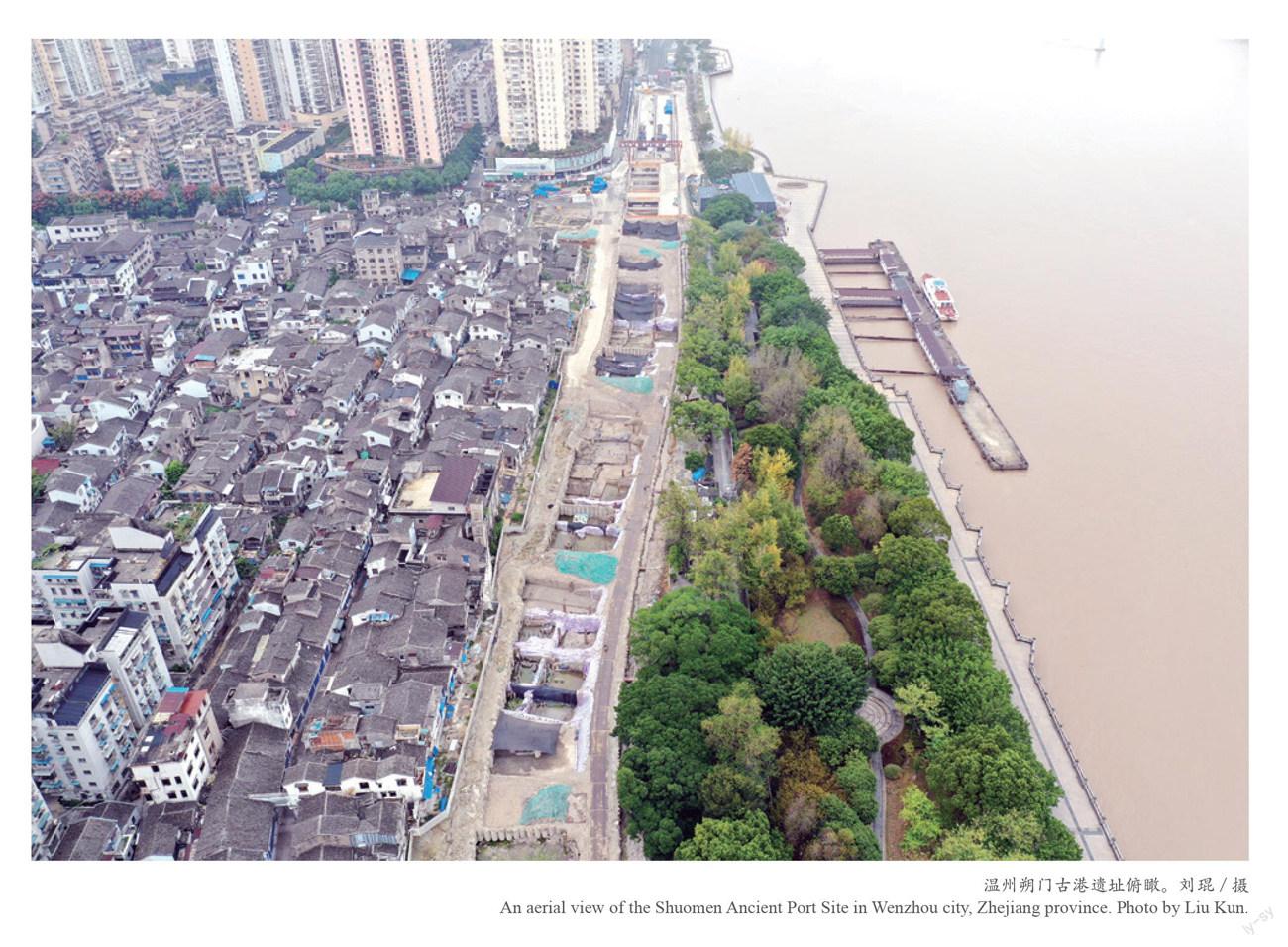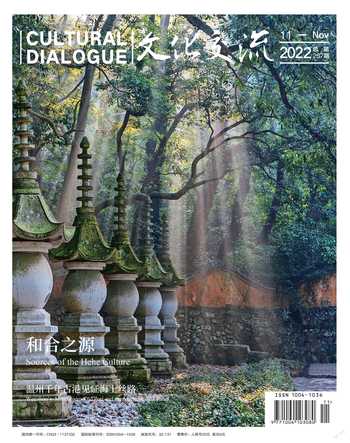温州千年古港见证海上丝路
2022-05-30应忠彭戚祥浩
应忠彭 戚祥浩



千年古港,遇见“海丝”。
9月28日,温州朔门古港遗址重大考古发现在国家文物局“考古中国”重大项目重要进展工作会上公布。考古专家称,该遗址规模大、遗迹全、年代清晰、内涵丰富,是城市、港口、航道三位一体的完整体系,堪称海上丝绸之路的绝佳阐释,也是海上丝绸之路不可替代的重要节点。
一时间,温州沸腾,大家仿佛看到了千年前温州北埠的繁荣景象,以及温州人由此出发闯世界的场景。千年古港遗址,也揭开了海上丝绸之路的历史面纱,成为在海丝之路的国际交往中展现中国风采的独特阐释,更为当今中国践行“一带一路”倡议、构建人类命运共同体提供生动的历史注脚。
探寻现场,穿越千年的瓷器锃亮依旧
层层叠叠的瓷器碎片堆积在一起,穿越千年而依旧锃光发亮;石头垒砌的古港码头一个连着一个,再现了古时温州的海上繁华景象……
古港遗址公布后,我们第一时间跟随考古人员来到现场近距离感受这一重大考古发现,穿越千年,寻找“一片繁华海上头”的先人遗迹。
温州市鹿城区望江东路东首,温州古城北大门——朔门之外,北邻瓯江,与江心屿双塔隔江呼应,朔门古港遗址就位于这一古代温州繁华之地。
2021年,为缓解交通压力、激活历史街区,原本打算将望江东路的地面道路改为下穿隧道,将地面改为休闲公园。据文物部门介绍,2004年,曾在其附近发现温州古城门北门遗址,因此施工开始后就同步介入了考古勘察。
“2021年10月下旬,在地面道路开挖过程中发现了一些古石条,我们就第一时间协助文物部门展开工作。”温州名城建设开发有限公司望江路下穿工程项目负责人说,文物部门顺着这些石条,在附近发掘出了越来越多的“宝贝”,不久,整个工程也就停了。
“小心,踩在泥巴上容易打滑。”温州市文物考古研究所所长梁岩华跟文物打了几十年的交道,说起这次发掘的经历仍难掩兴奋,带我们走进现场时,不忘提醒大家注意安全。
站在厚重的土地上,抬头望去,一片长约400米、宽10多米的狭长地带上,分布着大大小小不同的坑基,上面盖着黑色遮阳布,一些工人正对一旁的泥巴进行清理。梁岩华轻轻地捡起残留的一个瓷器碎片,阳光下,颜色碧绿、纹路清晰、光泽鲜亮。
“我们最初是在东首的水门头位置发现了连片的遗迹,之后又发现了8个码头遗址和两艘沉船。”梁岩华说,经浙江省文物考古研究所与温州市文物考古研究所联合考古勘探与发掘,古城水、陆城门相关建筑遗迹、成组码头、砖铺道路、木质栈道、干栏式建筑、水井、灰坑等保存较好的古代遗迹,以及数以吨计的宋元瓷片堆积和形式各样的漆木器等重要遗存逐渐“浮出水面”,各类遗存年代跨度从北宋延续至民国时期,尤以宋元为主。
泥里“淘宝”,再现千年繁华海上丝路
地处瓯江边,土层里多淤泥,再加上四五月份多雨水天气,对考古人员来说是一大考验。只见现场的几个坑基里还不时有水流进来,抽水机隔一定时间就要开展抽水作业。
对于现场发掘的遗存,文物部门还邀请省市专家、全国各科研院所的专家共同参与研究。“现在文化研究也要开放平台,吸引各路‘神仙参与。”梁岩华介绍,对于沉船年代、瓷器的分析等都运用了国内最先进技术进行鉴别。
在考古现场可以看到,由石头垒起来的古码头、栈道等遗迹呈横向分布,有斜坡式、台阶式。斜坡式码头依托山脚基岩而建,用块石砌筑而成,呈平缓斜坡状。台阶式码头自江岸向航道延伸,平面呈长方形或长条形台阶状,石包土心结构,码头中部填土上垫木板,板上铺平整方砖,砌筑考究。
据介绍,遗址发现的两艘沉船,其中一艘残存船头及部分船体,变形严重,且断成南北两段,总残长12.4米,最大残宽4.1米。壳板作鱼鳞状搭接,并楔有铁钉,可见技艺之精湛。根据隔舱板残存数量推测,该船全长约20余米,适合近海航行,被发掘出来后,已送至博物馆封闭保护。另外一艘还有待挖掘。
在现场,还能清晰地看到一些瓷器碎片。梁岩华介绍,目前已出土了数以吨计的古代瓷器残片,九成以上为龙泉窑产品,专家推断,应该是来自瓯江上、下游各个窑场。绝大多数的瓷片堆积呈现出条带状集中分布的状态,且年代集中于元代,堆积特征鲜明。这些瓷片多数都没有发现被使用的痕迹,推测为贸易瓷在运输、转运过程中的损耗品。遗址中还出土了部分温州漆器、捶丸、砖雕、建筑构件以及贝壳、植物种子等丰富遗物。
码头、瓷器、木船,仿佛再现了千年前码头上船来船往、人声鼎沸的繁荣交易景象。
抽丝剥茧,揭开千年古港面纱
历史是根,文化是魂。
一次考古,留下了无限的想象空间。除了实证,它更见证了浙江这片文化土壤的深厚,見证了“文化浙江”建设的蹄疾步稳。
作为此次遗址发掘参与者,温州博物馆研究员伍显军显得异常兴奋。他在温州博物馆“文物点阅室”介绍了部分“宝贝”。
“元代瓷器,碗的底部有一种拼音文字——八思巴文,这就是八思巴文碗。”“这是建盏,宋代人喜欢斗茶。建盏是一种在建窑时期烧制成的带有黑釉的茶碗,其外表为黑色,经常作为斗茶工具使用。这个建盏上有金丝兔毫纹路。”
除了出自龙泉窑的瓷品之外,其他窑系有瓯窑褐彩绘瓷、建窑系黑釉瓷(建窑、遇林亭窑、茶洋窑、吉州窑)、青白瓷系(义窑、景德镇窑)等。部分瓷器外底有墨书,如“姓氏+置”“置”“东”“西”“上”“纲”等。
“按目前进程预计,此次发掘的大量瓷器中,基本上能够修复完整的至少有1800件以上。”伍显军说,这批瓷器大多是生活用具,非常精美,而且内外纹饰艺术性非常强,比如对莲花纹、戳点纹的运用,呈现出自由发挥、不受拘束的风格特点,具有浓郁的乡村生活气息。
“考古除了关注瓷器本身之外,还要关注当时人们的生活状态,这次就发现了大量温州食物标本,比如稻谷。我们还发现了很多贝类,如贝壳、钉螺,这种钉螺是当时温州人喜欢吃的。考古还发现了荔枝、橄榄、桃子等果核,加上发掘的建筑遗址、茶盏、酒瓶等,可以想象当时在这个海边,可能有人在喝茶或喝酒,画面感很强。”伍显军说。
“文物点阅室”展示的文物中有一对捶丸特别引人注目。“在宋代,唐代的马布球演变成了捶丸运动,大人小孩都很喜欢。捶丸小巧玲珑,说明宋代人精神世界丰富,而且富有雅趣。”伍显军说,此次发掘还在陡门南边发现了唐代晚期的瓦当、中亚地区传过来的琉璃,“这些都说明,当时我们这边也是重要港口,中亚地区的产品输入温州”。
此次发掘的瓷器中还有大批瓯窑,包括温州西山窑。“宋代时期,西山窑走向顶峰,有几十个窑在工作,出来的瓷器非常精美。”伍显军说,还有非常精美的腰鼓等瓯窑瓷器,展现了温州特有的文化。
发掘的众多遗迹遗物中,沉船是一个焦点。专家通过码头岸线鉴定,一艘为南宋船,另一艘为北宋船。
“目前南宋船已被全部运往特定地点保存,由专业技术人员进行封装保存。”温州市文物考古研究所副所长刘团徽介绍,另一艘北宋船还未出土,露在表面的船部结构已用土工布遮盖,防止被太阳暴晒引起干裂。
对于沉船之谜,专家们有三个版本的推测。第一个版本:沉船为当时因船体坏损无法修复而被人为废弃,和此前发现的“瓷片带”类似,被废弃在江边。第二个版本:由于沉船周边发现了瓷器、铜钱等文物,有可能是遭遇台风或巨大风浪,沉没后被浪冲到江岸边,最终被深埋。第三个版本:两艘船在近海沉没,被人打捞回岸,长期闲置江边,经过岁月更迭、岸线推移,最终被埋入土中。
千年商港,温州人从这里走向世界
现如今,温州有海外侨胞、港澳同胞近70万人,在海外131个国家和地区组建了300余个温籍侨团,有38万温州人在“一带一路”沿线57个国家和地区创业发展。
温州人走世界的故事,从千年前就已经开始。“一片繁华海上头”“瓯居海中”,温州自东晋建城伊始,其城就与港口、江海密不可分,有着“东南之沃壤,一都之巨会”的美誉。
置身于庞大的遗址群前,脑海中浮现出元代画家王振鹏的《江山胜览图》,这一刻,我们仿佛置身于繁华的温州古城:穿过水陆城门,眼前是热闹喧嚣的码头、商铺,来自世界各地的船舶或停靠或远行。入夜,江心的古塔上点起了刺破夜空的长灯,照亮一艘艘远赴重洋的行船。海上丝绸之路的温州节点,是男儿们乘风破浪的起点。
大航海时代之前,海上丝绸之路已兴盛千年。
“云帆高张,昼夜星驰,涉彼狂澜,若履通衢。”中华民族的先辈们沿着海岸线,从宁波港、温州港、泉州港、广州港等扬帆出海,穿越惊涛巨浪,闯荡出联系东西方的一条海上丝绸之路。
在古港遗址,大量文物遗存于千年的静默无声中诉说着向海而生、因海而兴的故事。
遗址地层与遗迹中出土了大量古代遗物,尤以瓷器残片堆积最为丰富,并主要以宋元时期龙泉窑残片为主,当为贸易损耗品堆积遗存。可以想见,数量庞大的龙泉瓷器,沿着瓯江下游从温州入海,走向世界。
海上丝绸之路,不仅是中西方商品贸易之路,更是中西文化交融之路。包括温州港等在内的众多港口,如璀璨的珍珠,见证着各国人民利益交汇、情感交融的历史。
海上丝绸之路,始终是开放的产物,更是开放的助推力。千年来,一代代温州人顺着这条路走向全球,编织起全球贸易网络,种植下“世界温州人”的美名。
当海风吹拂千年,当足迹遍及世界,温州人成为中国人勇于探索、开放通达、交融合作的一个缩影。所有在海上丝路中闯荡的故事,亦融入了世界的记忆,成为世界人民共同的精神财富。
此刻,站在古港遗址前,我们聆听千年的回响——
从瓯江出发,跨过山峦起伏的大陆走向浩瀚无涯的海洋,江心孤塔黑夜長明,年年岁岁指引着海上的勇士搏击巨浪,也召唤着离家的亲人早日归来。
Wenzhous Millennium-Old Port and the Maritime Silk Road
By Ying Zhongpeng Qi Xianghao
On September 28, major archaeological discoveries of the Shuomen Ancient Port Site in Wenzhou were announced at the progress meeting of project “Archaeological China” organized by the State Administration of Cultural Heritage. Archaeologists said that the site features large-scale, complete relics, clear date and rich connotation. It is an integrated system of cities, ports and waterways, which can be regarded as an excellent interpretation of the Maritime Silk Road and an irreplaceable node as well.
Immediately afterwards, the city of Wenzhou was filled with excitement and everyone seemed to have witnessed the prosperous Northern Port of Wenzhou a thousand years ago, and the scene of Wenzhounese setting out for the world. The millennium-old port site has also unveiled the history of the Maritime Silk Road.
Right after the announcement, we followed archaeologists to the site to closely experience this major archaeological discovery and search for the relics of ancestors “on a prosperous sea”, which is located at the east end of Wangjiang East Road, Lucheng district, and outside Shuomen, the north gate of the ancient city of Wenzhou, a prosperous place since the ancient times.
Standing on the thick soil and looking up, we saw a narrow strip of about 400 meters long and a dozen meters wide, which were spread with pit foundations covered with black sunshade cloth. Liang Yanhua, director of the Wenzhou Institute of Cultural Relics and Archaeology, gently picked up a piece of the remaining porcelain. Under the sun, it shone green, with clear lines and bright luster.
“At first, we found a series of relics at Shuimentou to the east, and then eight dock sites and two sunken ships,” Liang explained. The relics span over a long history, from the 10th to the 20th centuries, especially rich in the 11th-14th centuries during the Song (960-1279) and Yuan (1206-1368) dynasties.
The site is located near the Oujiang River, with silt in the soil, and rainy weather in April and May was always an ordeal for archaeologists. In several pit foundations, water was still oozing in from time to time, so pumping operation started at regular intervals.
As is reported, two sunken ships have been found, one of which has a residual bow and part of its hull, both seriously deformed. The ship was broken into two parts, with a total residual length of 12.4 meters and a maximum residual width of 4.1 meters. The shell planks were lapped like fish scales and wedged with nails, showing superb workmanship. It is speculated from the number of its remaining partition boards that the ship was 20-odd meters long, suitable for offshore navigation. After its excavation, it has been sent to the local museum for sealed preservation. The other ship has yet to be excavated.
At the scene, we saw some porcelain fragments. Liang told us that tons of ancient porcelain fragments have been unearthed, more than 90 percent of which are products of Longquan Kiln. Experts concluded that they should have come from various kilns upstream and downstream of the Oujiang River. Whats more, some Wenzhou lacquerware, chuiwan (hammer balls), brick carvings, building components, seashells, plant seeds and other relics were also unearthed at the site. All of these seem to reproduce the scene of bustling people and prosperous transactions when they came and went on ships at the wharf a thousand years ago.
An archeological job has left an infinite space for imagination. In addition to empirical evidence, it has revealed the profundity of Zhejiang's cultural richness and the rapid and steady progress of the construction of a “cultural Zhejiang”.
As one of the excavators, Wu Xianjun, a researcher at the Wenzhou Museum, was very excited these days. He showed us some “treasures” in the Museum, such as a Yuan-dynasty bowl printed with a Phags-pa script on its bottom, a Fujian Kiln teacup with dark glaze and golden brush patterns. “From the current process, it is estimated that at least 1,800 porcelain pieces can be basically restored,” Wu said. Most of these porcelain products are household appliances, with exquisite artistic decorative patterns both inside and outside.
Among the cultural relics displayed in the “Cultural Relics Reading Room”, a pair of chuiwan balls is particularly eye-catching, “which are small and exquisite sports ware, showing the rich spiritual world and elegance of people in the Song dynasty,” Wu said.
To the south of Doumen Gate, eaves tiles made in the late Tang dynasty (618-907) and colored glaze from Central Asia are also found. “This shows that Wenzhou was also an important port at that time, and products from Central Asia were imported here.” A large number of Ou Kiln porcelains were found as well, including fine Xishan Kiln porcelain from Wenzhou, which reached its peak in the Song era. According to Wu, such Ou Kiln porcelain as an exquisite waist drum represents the unique culture in Wenzhou.
Among the numerous relics excavated, focus is placed on the shipwrecks. Judging from the wharf shoreline, the experts identified one wreck as a Southern Song dynasty (1127-1279) ship and the other as a Northern Song dynasty (960-1127) ship.
Today, Wenzhou boasts nearly 700,000 overseas Chinese compatriots; more than 300 Wenzhou overseas Chinese groups have been established in 131 countries and regions, and 380,000 Wenzhounese have started and developed their businesses in 57 countries and regions along the “Belt and Road”.
The story of Wenzhounese making a living overseas started a thousand years ago. Since the ancient city of Wenzhou was founded in the year 323, it has integrated with harbors, rivers and seas, and has a reputation as “a fertile land and a giant city”.
As we stand before the enormous sites, the painting Landscape of Rivers and Mountains by Yuan painter Wang Zhenpeng comes to mind. At that moment, we seem to be situated in the prosperous ancient Wenzhou:
Passing through the land and water city gates, we can see the bustling docks, shops, and ships from all over the world. By night, a long lamp that pierces the night sky is lit in the ancient pagoda in the middle of the river, illuminating ships sailing to the ocean. Wenzhou, sitting along the Maritime Silk Road, is always the starting point for Wenzhounese as pioneers in the world.
Across the vast ocean, the Maritime Silk Road is not only a route for Chinese and Western trade, but also a road for the integration of Chinese and Western cultures. Ports, including the Wenzhou Port, are like bright pearls witnessing the convergence of interests and feelings of various peoples.
Now, standing in front of the ancient harbor site, we listen to the echo of the millennium. Starting from the Oujiang River, we cross the undulating continent to the vast ocean. The lonely pagoda in the middle of the river is always bright at night, guiding the warriors in the sea to fight the waves day and night, and calling the wandering loved ones to return as soon as possible.
